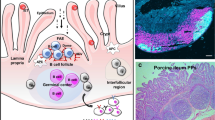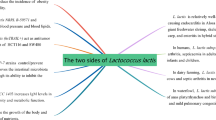Abstract
Effects of Gram-negative probiotic E. coli strain Nissle 1917 (EcN) on the production of nitric oxide (NO) and cytokines were determined in cultures of resident peritoneal cells of rats. The cells (2 × 106/mL) were cultured for 24 h in the presence of live EcN suspension (EcN-Susp), bacteria-free supernatant of this suspension (Sup-EcN), and LPS of EcN origin (LPS-EcN). The biosynthesis of NO was substantially enhanced using live bacteria counts as low as 103/mL applied in the form of EcN-Susp. The same NO-enhancing effect was produced by the correspondingly diluted Sup-EcN. It was found that Sup-EcN contained relatively high amounts of LPS. Administration of the LPS-EcN mimicked the high NO-augmenting activities of both Sup-EcN and EcN-Susp. However, the activity of LPS-EcN was significantly less pronounced than were the activities of Sup-EcN and EcN-Susp containing identical amounts of LPS. The NOstimulatory effects of the EcN preparations were completely inhibited by polymyxin B. All LPS-EcN and correspondingly diluted Sup-EcN and EcN-Susp stimulated the secretion of cytokines TNF-α, IL-1β, IL-6, IL-10 and VEGF. Also these effects were abrogated by polymyxin B. In contrast to the effects on NO production, the cytokine-stimulatory effects were significantly less pronounced after the exposure of the cells to Sup-EcN and EcN-Susp than to the identical amounts of LPS-EcN. It may be concluded that the in vitro stimulatory effects of EcN on NO and cytokine production are mediated by LPS. It is suggested that the immunostimulatory activity of LPS is modulated by EcN-derived factor(s), the nature of which remains to be identified.
Similar content being viewed by others
Abbreviations
- EcN:
-
Escherichia coli strain Nissle 1917
- EcN-Susp:
-
suspension of live EcN
- iNOS:
-
inducible nitric oxide synthase
- LPS:
-
lipopolysaccharide
- LPS-EcN:
-
LPS isolated from
- PBS:
-
phosphate-buffered saline
- PC:
-
peritoneal cells
- Sup-EcN:
-
bacteria-free supernatant prepared from EcN-Susp
References
Altenhoefer A., Oswald S., Sonnenborn U., Enders C., Schulze J., Hacker J., Oelschlaeger T.A.: The probiotic Escherichia coli strain Nissle 1917 interferes with invasion of human intestinal epithelial cells by different enteroinvasive bacterial pathogens. FEMS Immunol.Med.Microbiol.40, 223–229 (2004).
Bogdan C., Röllinghof M., Vodovotz Y., Xie Q.W., Nathan C.: Regulation of inducible nitric oxide synthase in macrophages by cytokines and microbial products, pp. 37–54 in Immunotherapy of Infections (K.N. Masihi, Ed.). Marcel Dekker, New York 1994.
Bogdan C., Vodovotz Y., Nathan C.: Macrophage deactivation by interleukin 10. J.Exp.Med.174, 1549–1555 (1991).
Chen B.C., Lin W.W.: Potentiation of lipopolysaccharide-induced IL-6 release by uridine triphosphate in macrophages: cross-interaction with cyclooxygenase-2-dependent prostaglandin E2 production. J.Biomed.Sci.6, 425–432 (1999).
Chen C.-C., Wang J.-K.: p38 but not p44/42 mitogen-activated protein kinase is required for nitric oxide synthase induction mediated by lipopolysaccharide in RAW 264.7 macrophages. Mol.Pharmacol.55, 481–488 (1999).
Connelly L., Palacios-Callender M., Ameixa C., Moncada S., Hobbs A.J.: Biphasic regulation of NF-κB activity underlies the pro- and anti-inflammatory actions of nitric oxide. J.Immunol.166, 3873–3881 (2001).
Cross M.L., Ganner A., Teilab D., Fray L.M.: Patterns of cytokine induction by Gram-positive and Gram-negative probiotic bacteria. FEMS Immunol.Med.Microbiol.42, 173–180 (2004).
Deakin A.M., Payne A.N., Whittle B.J., Moncada S.: The modulation of IL-6 and TNF-α release by nitric oxide following stimulation of J774 cells with LPS and IFN-γ. Cytokine7, 406–416 (1995).
Ding A.H., Nathan C.F., Stuehr D.J.: Release of reactive nitrogen intermediates and reactive oxygen intermediates from mouse peritoneal macrophages. Comparison of activating cytokines and evidence for independent production. J.Immunol.141, 2407–2412 (1988).
Duhé R.J., Evans G.A., Erwin R.A., Kirken R.A., Cox G.W., Farrar W.L.: Nitric oxide and thiol redox regulation of Janus kinase activity. Proc.Nat.Acad.Sci.USA95, 126–131 (1998).
Fiorucci S., Santucci L., Cirino G., Mencarelli A., Familiari L., Del Soldato P., Morelli A.: IL-1β converting enzyme is a target for nitric oxide-releasing aspirin: new insights in the anti-inflammatory mechanism of nitric oxide-releasing nonsteroidal anti-inflammatory drugs. J.Immunol.165, 5245–5254 (2000).
Förstermann U., Kleinert H.: Nitric oxide synthase: expression and expressional control of the three isoforms. Naunyn-Schmiedeberg’s Arch.Pharmacol.352, 351–364 (1995).
Gaillard T., Mülsch A., Klein H., Decker K.: Regulation by prostaglandin E2 of cytokine-elicited nitric oxide synthesis in rat liver macrophages. Biol.Chem.Hoppe-Seyler373, 897–902 (1992).
Gao J.J., Zuvanich E.G., Xue Q., Horn D.L., Silverstein R., Morrison D.C.: Bacterial DNA and LPS act in synergy in inducing nitric oxide production in RAW 264.7 macrophages. J.Immunol.163, 4095–4099 (1999).
Grozdanov L., Raasch C., Schulze J., Sonnenborn U., Gottschalk G., Hacker J., Dobrindt U.: Analysis of the genome structure of the nonpathogenic probiotic Escherichia coli strain Nissle 1917. J.Bacteriol.186, 5432–5441 (2004).
Grozdanov L., Zähringer U., Blum-Oehler G., Brade L., Henne A., Knirel Y.A., Schombel U., Schulze J., Sonnenborn U., Gottschalk G., Hacker J., Rietschel E.T., Dobrindt U.: A single nucleotide exchange in the wzy gene is responsible for the semirough O6 lipopolysaccharide phenotype and serum sensitivity of Escherichia coli strain Nissle 1917. J.Bacteriol.184, 5912–5925 (2002).
Hafez M., Hayes K., Goldrick M., Warhurst G., Grencis R., Roberts I.S.: The K5 capsule of Escherichia coli strain Nissle 1917 is important in mediating interactions with intestinal epithelial cells and chemokine induction. Infect.Immun.77, 2995–3003 (2009).
Helwig U., Lammers K.M., Rizzello F., Brigidi P., Rohleder V., Caramelli E., Gionchetti P., Schrezenmeir J., Foelsch U.R., Schreiber S., Campieri M.: Lactobacilli, bifidobacteria and E. coli Nissle induce pro- and anti-inflammatory cytokines in peripheral blood mononuclear cells. World J.Gastroenterol.12, 5978–5986 (2006).
Henker J., Laass M., Blokhin B.M., Bolbot Y.K., Maydannik V.G., Elze M., Wolff C., Schulze J.: The probiotic Escherichia coli strain Nissle 1917 (EcN) stops acute diarrhea in infants and toddlers. Eur.J.Pediatr.166, 311–318 (2007).
Hockertz S.: Immunomodulating effect of killed, apathogenic Escherichia coli, strain Nissle 1917, on the macrophage system. Arzneimittelforschung41, 1108–1112 (1991).
Ivec M., Botić T., Koren S., Jakobsen M., Weingartl H., Cencic A.: Interactions of macrophages with probiotic bacteria lead to increased antiviral response against vesicular stomatitis virus. Antiviral Res.75, 266–274 (2007).
Kallmann B.A., Malzkorn R., Kolb H.: Exogenous nitric oxide modulates cytokine production in human leukocytes. Life Sci.65, 1787–1794 (1999).
Kamada N., Maeda K., Inoue N., Hisamatsu T., Okamoto S., Hong K.S., Yamada T., Watanabe N., Tsuchimoto K., Ogata H., Hibi T.: Nonpathogenic Escherichia coli strain Nissle 1917 inhibits signal transduction in intestinal epithelial cells. Infect.Immun.76, 214–220 (2008).
Kruis W., Fric P., Pokrotnieks J., Lukás M., Fixa B., Kascák M., Kamm M.A., Weismueller J., Beglinger C., Stolte M., Wolff C., Schulze J.: Maintaining remission of ulcerative colitis with the probiotic Escherichia coli Nissle 1917 is as effective as with standard mesalazine. Gut53, 1617–1623 (2004).
Lammers K.M., Helwig U., Swennen E., Rizzello F., Venturi A., Caramelli E., Kamm M.A., Brigidi P., Gionchetti P., Campieri M.: Effect of probiotic strains on interleukin 8 production by HT29/19A cells. Am.J.Gastroenterol.97, 1182–1186 (2002).
Lander H.M.: An essential role for free radicals and derived species in signal transduction. FASEB J.11, 118–124 (1997).
Malchow H.A.: Crohn’s disease and Escherichia coli. A new approach in therapy to maintain remission of colonic Crohn’s disease? J.Clin.Gastroenterol.25, 653–658 (1997).
Marcinkiewicz J., Grabowsky A., Chain B.: Nitric oxide up-regulates the release of inflammatory mediators by mouse macrophages. Eur.J.Immunol.25, 947–951 (1995).
Mercenier A., Pavan S., Pot B.: Probiotics as biotherapeutic agents: present knowledge and future prospects. Curr.Pharm.Des.9, 175–191 (2003).
Mondel M., Schroeder B.O., Zimmermann K., Huber H., Nuding S., Beisner J., Fellermann K., Stange E.F., Wehkamp J.: Probiotic E. coli treatment mediates antimicrobial human β-defensin synthesis and fecal excretion in humans. Mucosal Immunol.2, 166–172 (2009).
Nissle A.: Weiters über Grundlagen und Praxis der Mutaflorbehandlung. Deutsch.Med.Wochenschr.44, 1809–1813 (1925).
Obermeier F., Gros, V., Schölmeric J., Falk W.: Interleukin-1 production by mouse macrophages is regulated in a feedback fashion by nitric oxide. J.Leukoc.Biol.66, 829–836 (1999).
Otte J.-M., Podolsky D.K.: Functional modulation of enterocytes by Gram-positive and Gram-negative microorganisms. Am.J.Physiol. Gastrointest.Liver Physiol.286, G613–G626 (2004).
Ouadrhiri Y., Sibille Y., Tulkens P.M.: Modulation of intracellular growth of Listeria monocytogenes in human enterocyte Caco-2 cells by interferon-γ and interleukin-6: role of nitric oxide and cooperation with antibiotics. J.Infect.Dis.180, 1195–1204 (1999).
Paoliello-Paschoalato A.B., Oliveira S.H., Cunha F.Q.: Interleukin 4 induces the expression of inducible nitric oxide synthase in eosinophils. Cytokine30, 116–124 (2005).
Patzer S.I., Baquero M.R., Bravo D., Moreno F., Hantke K.: The colicin G, H and X determinants encode microcins M and H47, which might utilize the catecholate siderophore receptors FepA, Cir, Fiu and IroN. Microbiology149, 2557–2570 (2003).
Peraldi P., Frodin M., Barnier J.V., Calleja V., Sciemeca J.C., Filloux C., Calothy G., van Obberghen E.: Regulation of the MAP kinase cascade in PC12 cells: B-Raf activates MEK-1 (MAP kinase or ERK kinase) and is inhibited by cAMP. FEBS Lett.357, 290–296 (1995).
Rogerio F., Teixeira S.A., Junior H.J., Maria C.C., Vieira A.S., De Rezende A.C., Pereira G.A., Muscara M.N., Langone F.: mRNA and protein expression and activities of nitric oxide synthases in the lumbar spinal cord of neonatal rats after sciatic nerve transection and melatonin administration. Neurosci.Lett.407, 182–187 (2006).
Ryu Y.H., Baik J.E., Yang J.S., Kang S.S., Im J., Yun C.H., Kim D.W., Lee K., Chung D.K., Ju H.R., Han S.H.: Differential immunostimulatory effects of Gram-positive bacteria due to their lipoteichoic acids. Internat.Immunopharmacol.9, 127–133 (2009).
Salkowski C.A., Detore G., Mcnally R., van Rooijen N., Vogel S.N.: Regulation of inducible nitric oxide synthase messenger RNA expression and nitric oxide production by lipopolysaccharide in vivo. J.Immunol.158, 905–912 (1997).
Schlee M., Wehkamp J., Altenhoefer A., Oelschlaeger T.A., Stange E.F., Fellermann K.: Induction of human β-defensin 2 by the probiotic Escherichia coli Nissle 1917 is mediated through flagellin. Infect.Immun.75, 2399–2407 (2007).
Schultz M., Strauch U.G., Linde H.J., Watzl S., Obermeier F., Göttl C., Dunger N., Grunwald N., Schölmerich J., Rath H.C.: Preventive effects of Escherichia coli strain Nissle 1917 on acute and chronic intestinal inflammation in two different murine models of colitis. Clin.Diagn.Lab.Immunol.11, 372–378 (2004).
Sirois J., Ménard G., Moses A.S., Bissonnette E.Y.: Importance of histamine in the cytokine network in the lung through H2 and H3 receptors: stimulation of IL-10 production. J.Immunol.164, 2964–2970 (2000).
Sobko T., Huang L., Midtvedt T., Norin E., Gustafsson L.E., Norman M., Jansson E.A., Lundberg J.O.: Generation of NO by probiotic bacteria in the gastrointestinal tract. Free Radic.Biol.Med.41, 985–991 (2006).
Stuehr D.J., Marletta M.A.: Induction of nitrite/nitrate synthesis in murine macrophages by BCG infection, lymphokines or interferon-γ. J.Immunol.139, 518–525 (1987).
Sturm A., Rilling K., Baumgart D.C., Gargas K., Abou-Ghazalé T., Raupach B., Eckert J., Schumann R.R., Enders C., Sonnenborn U., Wiedenmann B., Dignass A.U.: Escherichia coli Nissle 1917 distinctively modulates T-cell cycling and expansion via toll-like receptor 2 signaling. Infect.Immun.73, 1452–1465 (2005).
Tromm A., Niewerth U., Khoury M., Baestlein E., Wilhelms G., Schulze J., Stolte M.: The probiotic E. coli strain Nissle 1917 for the treatment of collagenous colitis: first results of an open-label trial. Z.Gastroenterol.42, 365–369 (2004).
Ukena S.N., Westendorf A.M., Hansen W., Rohde M., Geffers R., Coldewey S., Suerbaum S., Buer J., Gunzer F.: The host response to the probiotic Escherichia coli strain Nissle 1917: specific up-regulation of the proinflammatory chemokine MCP-1. BMC Med.Genet.6, 43 (2005).
Ukena S.N., Singh A., Dringenberg U., Engelhardt R., Seidler U., Hansen W., Bleich A., Bruder D., Franzke A., Rogler G., Suerbaum S., Buer J., Gunzer F., Westendorf A.M.: Probiotic Escherichia coli Nissle 1917 inhibits leaky gut by enhancing mucosal integrity. PloS One2, e1308 (2007).
Wang S., Yan L., Wesley R.A., Danner R.L.: Nitric oxide increases tumor necrosis factor production in differentiated U937 cells by decreasing cyclic AMP. J.Biol.Chem.272, 5959–5965 (1997).
Westphal O., Luderitz O., Bister F.: Über die Extraktion von Bakterien mit Phenol/Wasser. Z.Naturforsch.7, 148–155 (1952).
Xie Q.-W.: A novel lipopolysaccharide-response element contributes to induction of nitric oxide synthase. J.Biol.Chem.272, 14867–14872 (1997).
Yang W.W., Krukoff T.L.: Nitric oxide regulates body temperature, neuronal activation and interleukin-1β gene expression in the hypothalamic paraventricular nucleus in response to immune stress. Neuropharmacology39, 2075–2089 (2000).
Author information
Authors and Affiliations
Corresponding author
Rights and permissions
About this article
Cite this article
Zídek, Z., Kmoníčková, E., Kostecká, P. et al. Decisive role of lipopolysaccharide in activating nitric oxide and cytokine production by the probiotic Escherichia coli strain Nissle 1917. Folia Microbiol 55, 181–189 (2010). https://doi.org/10.1007/s12223-010-0027-4
Received:
Revised:
Published:
Issue Date:
DOI: https://doi.org/10.1007/s12223-010-0027-4




